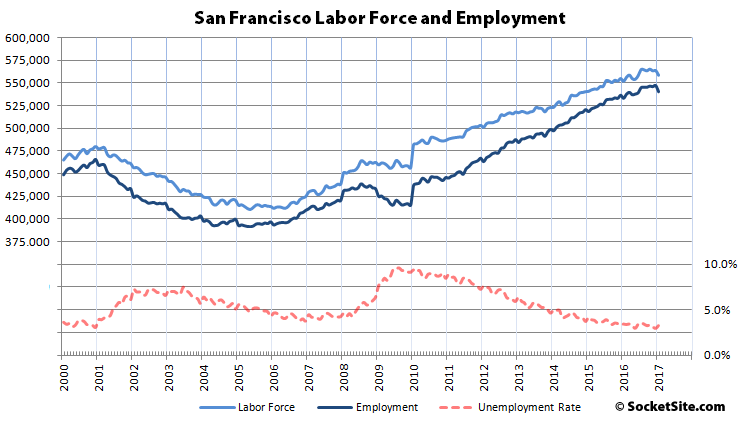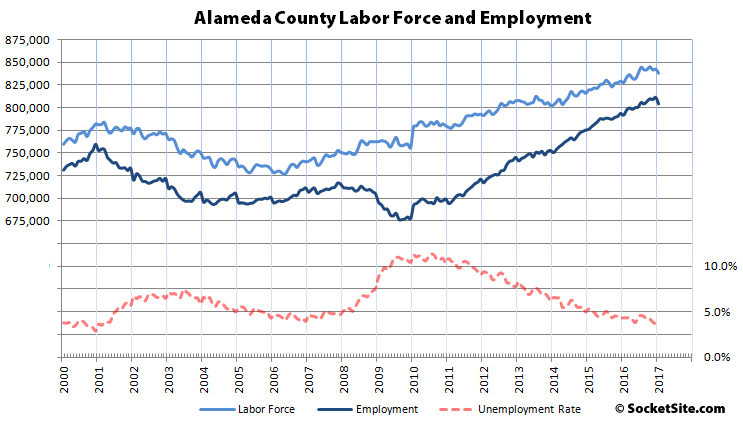While the upwardly revised December count of the number of people living in San Francisco with a job ended up adding 1,300 to the employment roll, the January count eliminated 6,900, which is the largest monthly drop in San Francisco employment since January 2009.
That being said, there are still 74,800 more people living in San Francisco with paychecks than there were at the end of 2000, an increase of 103,600 since January of 2010 and 7,200 more than at the same time last year, but the year-over-year gains have been trending down since the fourth quarter of 2014.
And with the labor force in San Francisco having shrunk by 5,200 people in January, the unemployment rate in the city has inched up from 2.9 to 3.2 percent.
In Alameda County, which includes Oakland, employment dropped by 7,200 in January following an upward revision in December (for its largest drop since January of 2009 as well) but remains 12,500 higher than at the same time last year, with an unemployment rate of 4.1 percent and 111,700 more employed residents since January of 2010.
Employment across the greater East Bay slipped by 12,200 in January and the unemployment rate inched up to 4.2 percent.
Up north, employment in Marin County slipped by 1,100 to 135,900 and the unemployment rate inched up to 3.2 percent.
And down in the valley, employment in San Mateo County dropped by 5,600 to 433,900 and the unemployment rate inched up to 2.9 percent while employment in Santa Clara County dropped by 9,400 to 987,100 and its unemployment rate inched up from 3.3 to 3.7 percent.


Looks like the VC funding is running out.
I don’t think greater East Bay employment is very sensitive to VC funding
It’s not “Greater Eastbay Employment” it’s Employment of persons who live in the Greater Eastbay, which includes substantial numbers of persons who commute from Alameda and Southern CoCo Counties into Santa Clara, as well as those who commute into SF. That having been said, I agree with you that the Eastbay as a whole is probably less sensitive than the West/Southbay’s.
Transbay BART tube is slammed shuffling tech employees between east bay and SF. You are probably not going to find any tech bros commuting from Fremont, but one of the main developers probably is.
Does it really?
All the apps will be made in Detroit from now on.
Oh, snap! Or just as preposterous, LA!
This data isn’t seasonally adjusted, so comparing month-to-month is inaccurate. In annual terms, San Francisco employment is still up by 46,600 jobs.
As we reported above, the year-over-year increase was actually 7,200, the smallest year-over-year gain in both absolute and relative terms since 2013.
In addition, while a portion of the recent drop is certainly due to seasonality, the drop was roughly three times the average drop for this time of the year as measured since 2010, or five times the average drop over the past decade.
Do we know anything about the income levels of the jobs being lost? Are these high or low paying jobs? This would be a better indicator for Real Estate purposes.
Despite the above average drop for this time of year, its still hard to know how to read this. Its a snapshot of one month and it needs context. How did employment fare in Seattle or LA or Atlanta during the same period.
The new administration has made me far more skeptical of our economic prospects. Big picture items like limiting H1-B visas and small picture ones like cutting off Caltrain electrification are all potentially damaging.
Here’s a more up to date story: Why Trump’s Attack on a California Railroad Should Trouble You.
Too bad the author didn’t quit while ahead and brought the Bullet Train nonsense into it: even BANG supports Caltrain while detesting the other, quite sensibly.
But yes, if the Bay Area is asked to actually pay for its own public transit – particularly SF and the bottomless money pit that is MUNI – it won’t have it as easy.
We’ve paid the money to the federal government in the taxes we pay… it’s sensible to think we should get it back
Trump didn’t get California’s electoral votes in 2016 and most importantly he has no chance of getting them in 2020. So there will not be much federal largess for us for the next four years.
Politics is all about getting re-elected and the administration knows where it’s bread gets buttered and where is doesn’t.
The train to nowhere is already way over budget while maintenance on the Oroville dam? It was not done and look where that is. Its not about just paying taxes, its about having our money spent judiciously. SF and California are examples of tax fund waste.
HSR will connect San Francisco and Los Angeles. Which one of those is the nowhere you talk about?
And what does this have to do with Caltrain electrification?
Dave, ‘train to nowhere’? If you look around the world, Japan, France, Germany, China etc. all have high speed trains connecting their most dynamic regions.
Just to give you an example. High speed rail might make it possible for thousands to commute from Modesto to San Jose for work. This might keep down rents in San Jose and boost the property values in Modesto and other parts of the Central Valley. These would be economic benefits that affect many many Californians. Do you account for those long term benefits when looking at the cost of the HSR project?
Exactly. Look at SF Muni, for example (Proposition A):
“Supervisors Blast SFMTA For Spending Only 2% Of $500 Million Voter Bond
Back in November 2014, 72 percent of San Francisco voters gave the thumbs-up to Proposition A, a $500 million bond for the SFMTA that was intended to improve and speed up Muni service.
But a little over two years later, only two percent ($12 million) of that $500 million has been spent, despite surging ridership and overcrowded buses and trains. And some members of the Board of Supervisors are not happy about it.”
I think the moderator of this site frowns on fact-free propaganda like “train to nowhere” and even “way over budget” is baseless. If you have some interesting demographic information on why either LA or SF is “nowhere” or why the Phase 1 projects which have uniformly come in below estimates can be called “over budget”, please share that data.
The funds did not come from the previous stimulus for CalTrain electrification. A Democrat regime was in place at that time, so I guess you have cause to worry they won’t come from the current GOP regime.
Per a recent report in the Mercury New, HSR could cost billions more than anticipated.
Dave, that report was prepared at by the federal government at the request of the CAHSRA to analyze the worst-case outcome.
As a general rule of thumb, backed up by considerable historical precedent, anything that is sourced as “according to the LA Times” should be looked upon with extreme skepticism. Perhaps you would care to balance it out by reading the rebuttal from the CAHSRA.
Maybe Dave was thinking of this article which is the article that your same source published…the very next day (it actually appears as a link right next to your story).
Or maybe not.
Same question, Dave: which is the nowhere? San Francisco or Los Angeles?
It’s an important point because this particular argument against HSR is completely intellectually dishonest.
The Oroville dam improvements were nixed by the Bush administration…
Yet spending billions an billions on freeways and interchanges, many with highly dubious economic rationales (except for making connected landowners rich) is seen as standard operating procedures and not even questioned in most of the National Automobile Slum. How much does major airport expansion cost?
H1-B are damaging. I have two friends who in the past year got canned from long time IT jobs, one at a major bank and one at a major utility, and asked to train their cheap inexperienced foreign replacements. And it also just happened at UCSF- just happened at UCSF
The new administration seems to be going full speed ahead with their agenda: “Starting April 3, 2017, USCIS will temporarily suspend premium processing for all H-1B petitions. This suspension may last up to 6 months.”
hm, strange. assuming things stay on track (big assumption) the IPO market is about to get really hot. with the market hitting new highs, the success of SNAP, and the weak IPO market of the past year or two, companies are going to try and take their shot while the going is good.
certainly doesn’t feel like we are on the precipice of a significant bay area downturn (but did it in 2006?)…
The issue is not SNAP or the FANGS, the issue is the thousands of other bay area startups that will go down the drain. Walk down some blocks and count how many startups you’ve never heard of – pretty much all of them will evaporate. The Bloomberg US Startups Barometer is down 24% over the LTM and 46% from its high in 2015.
How much employment is driven by startups, small or large? SNAP is interesting because even though it’s in LA, they’ve committed to paying Google at least half a billion dollars per year for cloud services. Obviously Google takes some of that as margin, but the gross amount is enough to employ 1000 senior engineers. That has to be putting money into the Bay Area economy.
Apple and Google are each worth more than every unicorn the Bay Area. The big companies are driving our economy, not the small ones.
Which is why employment has slipped and both sales, especially for new construction, and rents are down significantly in San Francisco?
….because those facts do not contradict each other, that’s why.
The big companies could be driving our economy AND new sales could be dropping.
Google and Apple BA employees number in the 10s of thousands in a region of millions. Most of which already have housing, most of which is in the south bay.
Interesting that people are assuming the drop was due to employer initiated reductions rather than employee flight from the area to cheaper places. As seen with Snap’s ipo it doesn’t require paying Bay Area rent to make Bay Area style tech money these days…
[Editor’s Note: There are a few good reasons we note changes in the labor force as well.]
Yes, it does, really. Any other cute retorts, petal?